One of the benefits of gardening with sandy soil is that it’s easy to dig and till, making transplanting easy. However, dry, sandy soil does not hold nutrients or water well. It takes additions of compost, mulch and organic matter over a prolonged period of time to build up enough soil nutrients for plants that require rich soils. Reduce your workload in the garden by choosing from the wide array of plants that thrive in sandy, nutrient-poor soil.
It is common to see the sandiest landscapes — like deserts and beaches — planted sparsely with drought-tolerant plants. That style of planting reduces the maintenance needs of the garden, because it will need less water and fertilizer than a more heavily planted landscape.
Before you start, perform a simple texture-based soil test to determine if you have sandy soil, and then explore below how to work with a sandy garden for low maintenance and gorgeous looks.
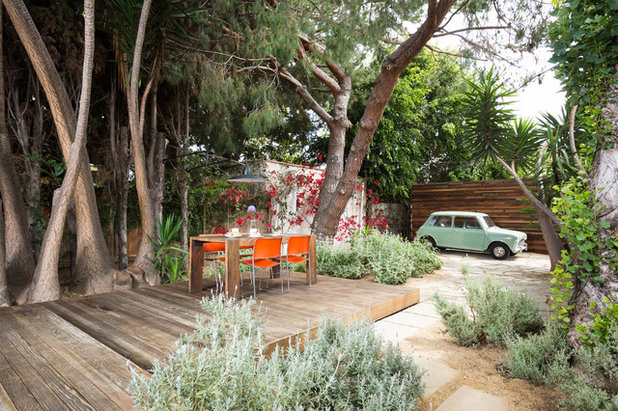
Hsu McCullough
In the garden featured here, a raised wooden deck mixes nicely with paving stones for a contemporary design.
With sandy soils, you often see lots of soil showing in arid and coastal climates. The soil has a strong visual presence — color, texture, brightness — that sets the overall look and feel of the garden. The way to work with the existing sand is to use a variety of materials that complement the sand’s tonal values (in art, “tonal values” means how light or dark a color is) and offset the plant-color relationships. Landscape architects and designers are skilled at understanding these color and texture relationships and will design a garden that works as a whole.
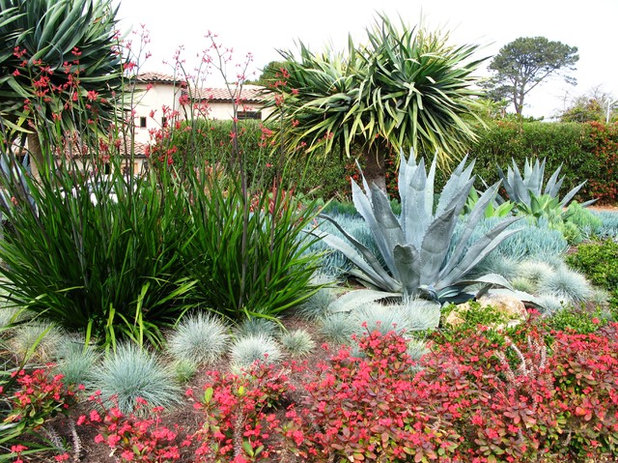
debora carl landscape design
Sand-Tolerant PlantsAs a general rule, drought-tolerant plants will perform well in dry, sandy soil that is well draining. Additionally, plants that are drought tolerant will also survive the nutrient-poor conditions of sandy soils. Your garden beds can be amended with compost, but using the right plants will mean less work in the long term.
This garden features a mix of strong-formed agaves along with grasses, wildflowers and additional succulents. All of these plants are drought tolerant and will survive in well-draining, sandy soil.
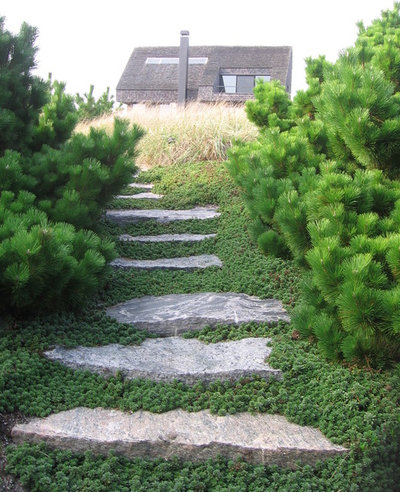
LaGuardia Design Group
Plants have forms and structures (in technical terms, these are called morphological characteristics) that help them survive a drought. Succulents have fleshy leaves that retain water, while the needles of conifers reduce water loss.
Many herbs and wildflowers also have very small or narrow leaves that help the plant retain moisture. Mulch certainly helps retain moisture at the soil surface, but selecting drought-tolerant plants for your landscape is an easier way to garden with sandy soil.
See more good plants for pathways
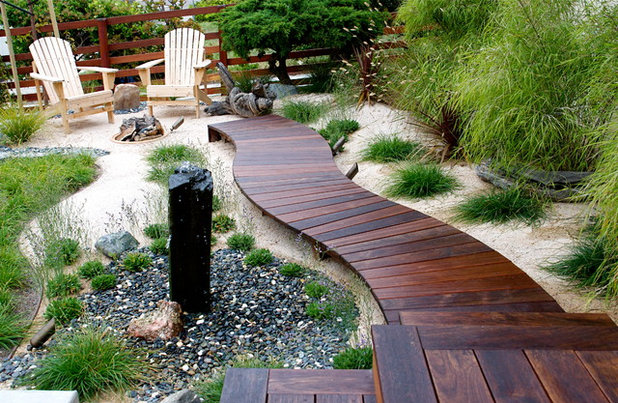
SD Independent Construction
Planning the Garden
Add pathways for unruly sand. Sandy soils can be unruly when trampled by feet frequently. A slightly elevated wooden boardwalk-style path is an elegant way to touch lightly on the ground and allow the sand to be unruly. Also, it will keep some of the sand off your shoes and, ultimately, out of your house.
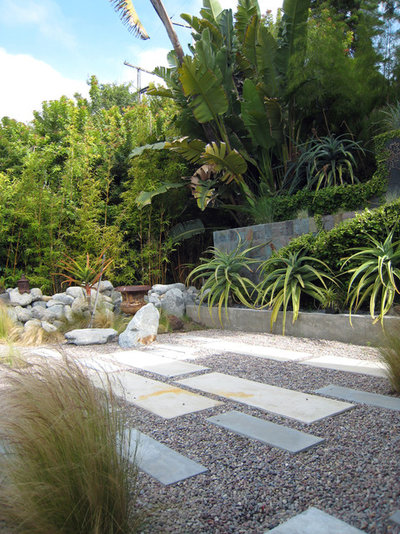
GEL: Griffin Enright Landscape
Incorporate stones. The newly popular arid gardens and xeriscape landscapes integrate stones as sculptural elements, adding interest to sparse plantings. The garden here has a combination of rugged stones, flat architectural pavers and a stone-faced wall. The similar colors of the stones create a cohesive look.
When selecting stones, work with your landscape architect to specify exact colors and finishes. Ask for samples of the selected stone types so that you can place them in your yard and see how they look under different light conditions and when they are wet. Observing the way they look on your site for a few days will help you make the right decision on stone color.
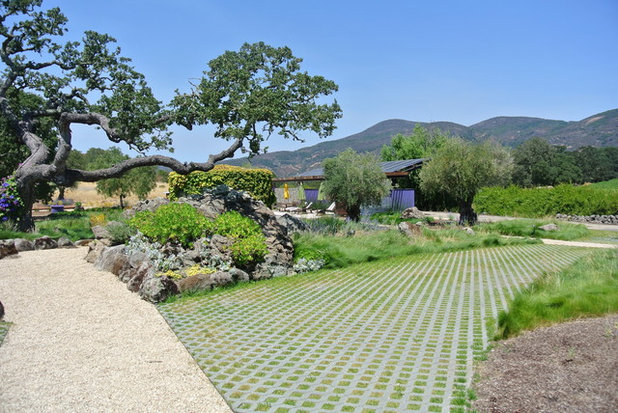
Shades Of Green Landscape Architecture
Use permeable paving. The great thing about sandy soil is that it allows for excellent drainage. The permeable pavers used for this driveway are an environmentally friendly way to provide a driving surface, because they allow water to infiltrate the ground instead of become runoff. If you have sandy soil, permeable paving surfaces will drain water quickly while reducing the impact of the paving.
The concrete grid in the driveway here is cast-in-place concrete, reinforced with rebar and installed using plastic spacers that create plantable voids. When the concrete has set, the plastic spacers are removed. In the voids, grass plugs, sod or grass seed is dispersed to grow as a green ground cover that fills in the spaces between the concrete. There are also other permeable paving products based on modular pieces that fit together.
Permeable paving can work with any soil type, but existing sandy soil will require less subgrade-drainage-layer construction and less labor to install.
Browse hundreds of photos showing permeable paving in landscape design
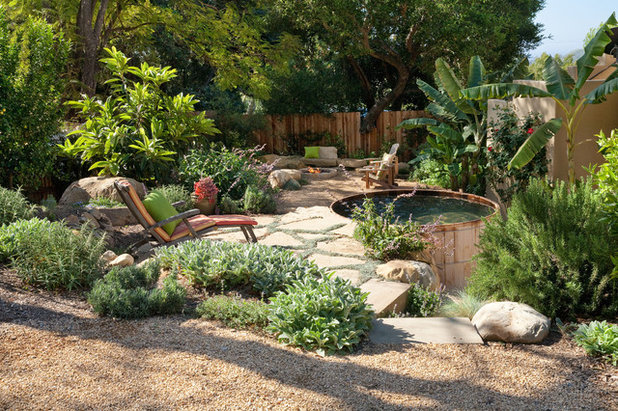
Margie Grace - Grace Design Associates
Shrink your water elements. In the traditional desert garden, water is used as the precious commodity that it is — in small focal-point fountains or narrow runnels that carry a trickle of water.
For a sandy garden with drought-tolerant plants, I recommend thinking about water elements as small focal points used to create the mood or feeling of water without overwhelming the garden. The tub here is nestled nicely into the flagstone patio and is an appropriate scale for a medium-size yard.
Using small water elements in a dry, sandy garden is both an aesthetic and environmental choice. If your sandy garden is in an arid or coastal climate, there is likely a higher evaporation rate from the water body due to high temperatures and strong winds. Keeping the water element small is a way to diminish water loss.
More:8 Unthirsty Plants Help you Save Water in Style
The Simple Secret to Gardening Success
Gardening Solutions for Heavy Clay Soils





